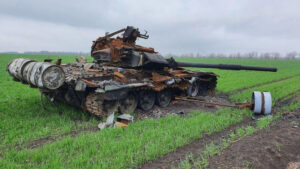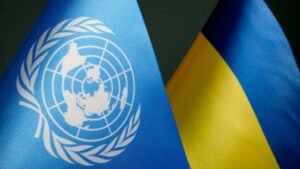
Russia’s full-scale invasion of Ukraine has virtually eliminated the demand for foreign currency loans, contributing to a reorientation to lending in the national currency, which is a good indicator for the economy, according to Pervin Dadashova, director of the NBU’s Financial Stability Department.
“Hryvnia lending prevails, and in general, in principle, the hryvnia is more attractive for lending than foreign currency. This is very important, and I think that this love for lending in hryvnia should continue,” she said at a discussion held by the Center for Economic Strategies (CES).
Dadashova noted that earlier the main motivation for foreign currency lending was lower interest rates on such loans, which led to problems in the absence of real needs and revenues in foreign currency. According to her, the risks of foreign currency lending, which increased during the war, have sharply reduced business interest in the dumb
The Director of the NBU’s Financial Stability Department noted that the loan portfolio has recently stabilized and returned to a slight increase, and now banks are faced with the task of compensating for its loss during the war, which, according to various metrics, amounted to about 15%.
“Now the quality of the loan portfolio is absolutely normal, it is even better than before the war. That is, banks are not losing as much credit risk as they did a few months ago,” the expert emphasized.
She clarified that the small growth in the loan portfolio so far is largely due to the growth under government support programs.
“However, a greater openness to new lending is already noticeable, including in our surveys,” Dadashova noted.
Among other trends, she noted an increase in the share of small and medium-sized businesses (SMEs) in the loan portfolio to more than 50%.
“A significant part of them belongs to business groups, so it is not a pure small business, it is still a big business, but it is structured in a certain way. But in the total portfolio, 15% of loans are granted to debtors who do not belong to business groups,” the expert said, emphasizing that they are a “good engine” for market lending.

After Azerbaijan established control over the former Nagorno-Karabakh, the Transcaucasus region entered a new era, where the political and economic prospects of the countries of the region became a subject of discussion in the international arena. In light of this, experts from various countries are analyzing the current situation and trying to predict the future of relations between the countries in the region. A new video published on the YouTube channel “Experts club” was devoted to this very topic, in which Azerbaijani military analyst, leading expert of the analytical center “STEM” Agil Rustamzadeh and the founder of the Kiev analytical center “Experts club”, candidate of economic sciences Maxim Urakin shared their opinion on the situation.
Military-political aspect
The experts emphasize the importance of the reached mutual understanding on the Karabakh issue.
“The resolution of the conflict has created a basis for the resumption of diplomatic dialog and economic cooperation between the countries of the Transcaucasus. Azerbaijan’s confrontation with Armenia is conditioned not only by the Karabakh conflict, the point is that those people who created this geopolitical paradigm were engaged in shaping the worldview of the Armenian population. A part of the Armenian population still believes that they once had a state that included the territories of Azerbaijan, Turkey and Georgia. With the emergence of Western institutions and the change of Armenians’ views, they begin to realize that enmity with such a geopolitical player as Turkey is a dead-end way of the country’s development. It is a way to nowhere, especially when these countries have no territorial claims to you, but you have territorial claims to your neighbors,” Rustamzadeh stressed.
The expert also notes that the signing of a possible peace treaty will give Armenia an impetus to move to a new level of development, will allow it to become not an object but a subject of international politics.
“I meet such an opinion both in Azerbaijan and Turkish colleagues. It is that under certain changes Turkey and Azerbaijan can become the guarantor of Armenia’s territorial integrity. Therefore, I believe that with the pragmatism shown by the Armenian people, the government and the political elite of Armenia, Armenia has chances to become a pro-Western democratic country,” Rustamzadeh said.
In his opinion, in order to ensure long-term stability, it is necessary to analyze all aspects of the conflict and its consequences for regional security.
Economic aspect
Maxim Urakin emphasized the economic sphere of relations between the countries of the region.
“Economy and politics are closely linked, and trade relations between the countries of the Transcaucasus play an important role in shaping the political landscape of the region,” Urakin noted.
The expert also drew attention to how export destinations affect the countries’ political preferences.
“Most of Azerbaijan and Iran’s exports are directed to Europe and Asia, while Turkey’s exports are much more diversified,” the economist emphasized.
Urakin also analyzed each country’s exports and their trade relations in detail, emphasizing the interconnectedness of economic and political factors in the region.
Development Prospects
Rustamzadeh and Urakin agree that further sustainable development of the region requires further work to resolve the remaining conflict situations and increase economic cooperation between the countries.
“Restoring trust and strengthening economic ties between the countries of the Transcaucasus will contribute to the creation of a favorable climate for investment and growth of the regional economy,” Rustamzadeh concluded.
You can learn more about the prospects of development of the Transcaucasus after the end of the Karabakh conflict from the video on the Experts club channel at the link:
Subscribe to the channel here:
ARMENIA, AZERBAIJAN, CAUCASUS, KARABAKH, NAGORNY_KARABAKH, RUSTAMZADEH, URAKIN, WAR

During the war, direct and indirect losses of the agricultural sector reached $40.2 billion, but these are not the final figures, as Ukrainian territories are still under temporary occupation, so it is difficult to calculate the full extent of losses, said Oleksandr Haidu, chairman of the Verkhovna Rada Committee on Agrarian and Land Policy.
“Confirmed direct losses of the agricultural sector exceeded $8.7 billion. We are talking about the destruction of infrastructure, business facilities, logistics chains, destruction and theft of grain and agricultural machinery by the enemy. There are also indirect losses of at least $30.5 billion. Unfortunately, this is not the final figure. When we accurately calculate the damage caused by the enemy’s explosion of the Kakhovka hydroelectric power station, the amount will be much higher,” the MP said on Wednesday at the conference “18 Months of War. Damage to the agricultural sector and prospects for the industry’s recovery”.
According to him, it is difficult to assess the consequences of contamination of agricultural land with explosives, destruction of the upper layers of soil due to “arrivals” and explosions during demining.
“We see that a large area is mined. Potentially, 174 thousand square kilometers of Ukrainian land are contaminated with explosives. And this is without taking into account the temporarily occupied regions,” the MP noted and informed about the preparation of the draft law “On the Quality of Soils”.
Gaidu also emphasized that the state cannot cover the needs of the affected farmers on its own and promised to engage international partners to support the agricultural sector.
“I emphasized the expediency of differentiating programs for farmers. After all, the needs of farmers are very different. For example, those farms that operate in the de-occupied territories cannot attract investment because financial institutions are mostly unwilling to cooperate with them. Although they are the first to return to their places after the liberation of the region to resume their activities and fill local budgets,” he wrote on Facebook.
The chairman of the relevant parliamentary committee believes that one of the mechanisms for compensation for the damage could be “grain reparations,” a mechanism that would help farmers receive compensation for destroyed businesses.

Civilian casualties from February 24, 2022, after Russia launched a full-scale war against Ukraine, to September 10, 2023, totaled 27,149 (26,717 as of August 27), including 9,614 deaths (9,511), the Office of the UN High Commissioner for Human Rights (UN OHCHR) reported.
“The UN OHCHR considers that the actual number of civilian deaths or injuries is significantly higher, as many reports from locations where such incidents have occurred continue to require further confirmation, while information from some locations where fighting continues has been delayed,” the document said regarding the UN data.
This applies, for example, to such localities as Mariupol (Donetsk region), Lisichansk, Popasnaya and Severodonetsk (Luhansk region), where numerous civilian deaths or injuries have been reported.
According to confirmed UN figures, 4,461 men, 2,672 women, 289 boys and 236 girls were killed, while the gender of 29 children and 1,927 adults could not yet be ascertained.
Among the 17,535 injured, 516 boys and 378 girls were killed, while 286 children whose gender could not yet be determined.
Compared to August 27, five children have died and 14 others have been injured.
While the UN OHCHR casualty count summary was previously issued daily, and then only on weekdays, it became weekly from July 2022 and biweekly from the end of May 2023. This summary, like the previous one, provides data by month.
According to them, the UN recorded the deaths of 55 civilians in 10 days in September. In August, the number of new deaths reported dropped to 147 from 161 in July, 186 in June, 174 in May, 182 in April, 181 in March and 144 in February.
The deadliest month for civilians, the UN points out, remains March last year, with a minimum of 4,168 deaths. In April 2022, according to an OHCHR publication, the number of civilian deaths due to war fell to 823 in April, 550 in May, 429 in June and 386 in July. There were 375 deaths in the first five days of the war from February 24 to February 28, 340 in August last year, 408 in September, 310 in October, 188 in November, 206 in December and 201 in January this year.
The number of wounded in the 10 days of September was 237, compared with 565 in August, 688 in July, 679 in June, 685 in May, 492 in April, 592 in March, 457 in February, 538 in January this year, 617 in December and 541 in November last year. In October, the number of injuries dropped to 795 from 983 in September, when it was up from August’s 921. Prior to that the monthly number of wounded exceeded a thousand: July, 1,131; June, 1,109; May, 1,139; April, 1,896; March, 3,001. In the first five days of the war last February, 469 people were wounded.
The UN OHCHR specifies that since the beginning of September, explosive weapons have killed 54 people and injured 170 others, while mines and explosive remnants of war have killed one person and injured 16 (6%).
Government-controlled territories accounted for 79% of casualties in the first 10 days of September, according to the UN.
The summary traditionally states that the increase in figures to the previous summary should not be attributed solely to cases after August 27, as during this period the Office verified a number of cases from the previous days.
Source: https://www.ohchr.org/en/news/2023/09/ukraine-civilian-casualty-update-11-september-2023

The National Agency for the Prevention of Corruption (NAPC) has included Turkish Şişecam Group, which is the largest exporter in the Russian Federation in its industry, in the list of international sponsors of war, the press service of the NAPC reports.
The main areas of activity of the company are glass and chemical production. Şişecam Group is the world’s second largest producer of glassware, the fifth largest producer of glass containers and sheet glass, and a world leader in the production of soda ash and chromium-based chemicals.
Şişecam’s 2022 revenue increased to $3.6 billion and net profit to $740 million.
Since the start of Russian aggression in 2014, Sisecam Flat Glass has been producing architectural, construction and automotive glass in Russia at the Alabuga SEZ in the Republic of Tatarstan. In Russia, Şişecam’s consolidated production volumes of flat glass, glassware and glassware exceed 1.5 million tons per year, with total investments of $1.25 billion. The company provides jobs for 3,414 employees at its plants in Russia, thereby creating jobs and supporting the terrorist state’s economy.
In particular, Şişecam Group’s subsidiaries producing sheet glass, glassware and glass containers paid more than $11.2 million in taxes to the Russian Federation in 2022.
The NAPC release notes that there was no attempt to condemn Russia’s war against Ukraine from the company’s management.
Şişecam Group has two assets in Ukraine – Pivdenna Brewery LLC and Merefianska Sklana Kompaniya.

In Ukraine from April 1, 2022 to April 1, 2023, 203.921 thousand FOPs were closed, while at the same time 208.936 thousand new FOPs and more than 32 thousand companies were registered, according to analytical materials “Opendatabot.”
“Despite full-scale hostilities and blackouts, business in Ukraine continues to grow. At the beginning of April 2023, the total number of registered FPOs amounted to 1.9 million, companies – more than 1.2 million,” – reported in the review.
It is reminded that from the beginning of full-scale war and almost till the end of March, the Unified State Register did not work, therefore it was impossible to register a new business or to close an existing one in the legal field. All data refers to the period from April 1, 2022 to April 1, 2023.
As noted, the military year was not a record for the closure of businesses: at the beginning of April 2023, 203.921 thousand FOPs were closed, while in previous years in Ukraine on average 260 thousand FOPs were closed per year.
At the same time, during the analyzed period – from April 1, 2022 to April 1, 2023 – 208.936 thousand new FOPs were registered.
As the analysts of “Opendatabot” note, in contrast to small and medium-sized businesses, the number of new companies significantly exceeded the number of closed ones. More than 32,000 companies were registered during the war, while 5,728 businesses ceased operations and became inactive.